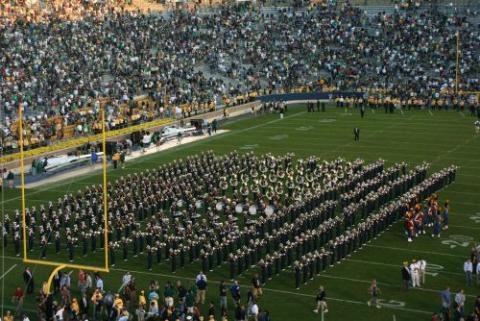
(Unsplash/Mariusz Prusaczyk)
On Oct. 13, the Iowa State University football team pulled off an upset win over the top-10 West Virginia University Mountaineers, but the highlight of the night was the Iowa State marching band's Jurassic Park halftime show, which featured 60 band members running around the field in dinosaur costumes.
To the tape:
That's 60 costumes you see there at $50 a pop, for a grand total of $3,000 spent on the gag.
"Frankly, it costs more money just to feed the marching band than it does to outfit them in dinosaur costumes," band director Christian Carichner told SB Nation. (Carichner seems to have a very good sense of humor in both band performance planning and media interviews.)
Unsurprisingly, the halftime show went viral. I sent the clip to my younger sister right away, who had already seen it, of course, because we are both big-time marching band geeks. She (trombone) and I (trumpet) were both members of the marching band at the University of Notre Dame, though not at the same time and never in prehistoric costume. College sports are a strange and uniquely American obsession, but they allowed us to travel around the country, playing music for tens of thousands of people at a time.
There were also plenty of life lessons about what it means to be a part of a community. Here are five.
(Note: My wife, a former high school water polo star goalie, upon finding out I was writing about marching band: "Isn't this column supposed to be about sports?" Well, marching band is an athletic-ish endeavor and it's a big part of the college football experience, so I'm rolling with it.)
1. Learning by doing is a great way to learn.
I remember my first day of Notre Dame band camp freshman year so vividly. Everyone who hoped to make the band — about 500 students — gathered a few days before classes started to practice music and marching before auditions on Sunday evening. I got to the band building that first morning, found my nametag, took out my trumpet, and went outside to stand in a huge block, eight people across. They sprinkled the freshmen between returning band members. I thought they'd give us some instructions about what was about to happen.
Nope.
The drum majors led us in a warm-up scale, then Katie, the head drum major, blew her whistle and the band snapped to attention, shouting "Irish!" at the top of our lungs. Well, all the upperclassmen did this. We freshmen were confused and utterly shook.
I looked to the trumpet players next to me to see how one stands at attention in the Notre Dame band, which was different than we had done in high school. Katie blew her whistle again, the drumline started playing, and we started marching. The Notre Dame band uses a weird high step that barely any high schools use, and there's an arm swing that requires one to slam his or her own chest with ferocity, and each of the sections have certain cheers during the various drum cadences, plus cheers that the whole band does together. We condensed the block to four people across then expanded it back out to eight again. After a few minutes, the drumline went into an introductory cadence, and we played the "Notre Dame Victory March" and then another school song.
Here's the thing about the parade that amazes me to this day: None of this was ever explained to us. We never sat down for a meeting in the band building to learn the cheers or when to play which song. You just figured it out as you went, learning from those around you. It was thrilling. And it was such an effective pedagogical model. The following years were even more fun, as I got to watch the new freshmen freak out at the first whistle and welcome them into the band through my example.
This approach reminds me of one of Pope Francis' points in his apostolic exhortation Evangelii gaudium ("The Joy of the Gospel"): We are all called to actively share the joy of our faith with others, even if we don't have advanced theological degrees. There's no sitting on the sidelines, waiting for someone to explain each and everything little thing to you. "It would be insufficient to envisage a plan of evangelization to be carried out by professionals while the rest of the faithful would simply be passive recipients. … So what are we waiting for?"
Francis has the drum major whistle. Time to march.
Advertisement
2. In a really big community, find a sub-community.
My high school marching band had 60 total members. The trumpet section at Notre Dame alone had 80 players. The band itself was over 400 members large, so there was no way to get to know everyone. Everything was done in sections, divided up by instrument. We had three trumpet section leaders, who were supported by 15 or 20 "core band" members, upperclassmen who had been selected for the leadership positions. We socialized together, learned the music together, bussed to away games together. To be honest, the trumpet section as a whole was a little too brash for me (people who choose to play the brashest instrument are a little over-the-top in a large group, it turns out), but my best college friend was a trumpet player, and so was his now-wife.
The best parishes I've ever known use a similar model, developing a "community of communities" that allows people to get to know a smaller group of parishioners through faith-sharing groups and other ministry teams in between the much larger liturgical gatherings on Sundays. Of course, there is also incredible value in having a big, united community gathered as one, because …
3. A group singularly focused together on one task can make magic.
One of the coolest pieces of music we played was a warm-up — something we never even performed on the football field. You know the famous "deep note" they play in THX-certified movie theaters, which crescendos for a few seconds before it reaches its Earth-shattering peak? Our piece was sort of the marching band version of that. It was a simple series of chords with a propulsive drum cadence underneath, repeated three times, louder each time. Man. It was so loud by the end. I get shivers just thinking about it. The same piece played by a lone soloist? Hilariously tepid and boring. The Notre Dame band's power came from each of its members doing their part to make the full sound, even if you could never pick out the specific contributions of any one particular individual.
I can confidently tell you that St. Paul had never heard a great marching band when he wrote about how a body needs all its various parts to function properly — and so also the body of Christ, the community — but he would have dug it. "If a marching band were all piccolos, then where would the bass sound be?"

University of Notre Dame marching band, September 2008 (Wikimedia Commons/Ben Franske)
4. Seek a balance between seriousness and levity.
One moment, you're all standing at attention, still as a statue, doing the thousand-yard stare. The next, you're doing a complex, choreographed Napoleon Dynamite dance to Jamiroquai's "Canned Heat" in front of 80,000 people. Just when I'd worry the Notre Dame band was taking ourselves too seriously, with all the talk about capital-H "History" and capital-T "Tradition," we'd bust out ridiculous dance numbers. I could never tell if our fellow students in the bleachers were laughing with us or at us. I think "with."
Do we in the Catholic Church, also built on history and tradition, laugh at ourselves enough? Do we think our faith is important enough to not take it so seriously all the time?
5. A good leader empowers other leaders.
I don't think I had a single conversation with the band's head director during my three years in the trumpet section. He was a bit intimidating, sure, but the main reason for this lack of connection was that I had dozens of other leaders to talk to if I had a question or needed something. There were assistant directors, drum majors and band officers, and the aforementioned section leaders and core band members. Plus, as we were learning a whole new show for each and every home game of the season, you'd be placed into a "rank" of four band kids, each a mix of veterans and newcomers, and you'd learn your steps together as a mini unit.
I'm kind of a control freak, and if I were in charge of the band, I'd probably want to teach everything to everyone all by myself. But the band's multi-tiered leadership structure led to increased buy-in from the musicians across the board. Younger members saw the leadership of the upperclassmen and aspired to step into those roles someday. Older members saw the promise of particular young leaders and called on them to use their enthusiasm and talent in service to the band community — planning for their own successors, in essence. I don't think I've ever been part of any other group that had such a developed leadership system. It was a great model.
So, if you flip on a college football game this fall, I hope you take note of the band and appreciate them not just for their school spirit and musical acumen, but for how they model some essential elements of what makes a good community — whether they're wearing typical uniforms or awesome dinosaur costumes.
[Mike Jordan Laskey is the director of Life & Justice Ministries for the Diocese of Camden, New Jersey. He blogs for the Camden Diocese at camdenlifejustice.wordpress.com.]
Sign up for email updates for future articles in the series, The Gospel of Sports.





